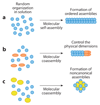Reductionist Approach in Peptide-Based Nanotechnology
- PMID: 29925257
- PMCID: PMC6352959
- DOI: 10.1146/annurev-biochem-062917-012541
Reductionist Approach in Peptide-Based Nanotechnology
Abstract
The formation of ordered nanostructures by molecular self-assembly of proteins and peptides represents one of the principal directions in nanotechnology. Indeed, polyamides provide superior features as materials with diverse physical properties. A reductionist approach allowed the identification of extremely short peptide sequences, as short as dipeptides, which could form well-ordered amyloid-like β-sheet-rich assemblies comparable to supramolecular structures made of much larger proteins. Some of the peptide assemblies show remarkable mechanical, optical, and electrical characteristics. Another direction of reductionism utilized a natural noncoded amino acid, α-aminoisobutryic acid, to form short superhelical assemblies. The use of this exceptional helix inducer motif allowed the fabrication of single heptad repeats used in various biointerfaces, including their use as surfactants and DNA-binding agents. Two additional directions of the reductionist approach include the use of peptide nucleic acids (PNAs) and coassembly techniques. The diversified accomplishments of the reductionist approach, as well as the exciting future advances it bears, are discussed.
Keywords: bionanotechnology; molecular materials; molecular recognition; peptide engineering; self-assembly; supramolecular chemistry.
Figures





Similar articles
-
Bioinspired Amino Acid Based Materials in Bionanotechnology: From Minimalistic Building Blocks and Assembly Mechanism to Applications.ACS Nano. 2024 Jan 16;18(2):1257-1288. doi: 10.1021/acsnano.3c08183. Epub 2023 Dec 29. ACS Nano. 2024. PMID: 38157317 Review.
-
Supramolecular Architectures of Nucleic Acid/Peptide Hybrids.Int J Mol Sci. 2020 Dec 12;21(24):9458. doi: 10.3390/ijms21249458. Int J Mol Sci. 2020. PMID: 33322664 Free PMC article. Review.
-
Self-assembly of Functional Nanostructures by Short Helical Peptide Building Blocks.Protein Pept Lett. 2019;26(2):88-97. doi: 10.2174/0929866525666180917163142. Protein Pept Lett. 2019. PMID: 30227810 Free PMC article. Review.
-
Molecular self-assembly using peptide nucleic acids.Biopolymers. 2017 Jan;108(1):10.1002/bip.22930. doi: 10.1002/bip.22930. Biopolymers. 2017. PMID: 27486924 Free PMC article. Review.
-
The physical properties of supramolecular peptide assemblies: from building block association to technological applications.Chem Soc Rev. 2014;43(20):6881-93. doi: 10.1039/c4cs00164h. Chem Soc Rev. 2014. PMID: 25099656 Review.
Cited by
-
Peptide Self-Assembled Nanocarriers for Cancer Drug Delivery.J Phys Chem B. 2023 Mar 9;127(9):1857-1871. doi: 10.1021/acs.jpcb.2c06751. Epub 2023 Feb 22. J Phys Chem B. 2023. PMID: 36812392 Free PMC article. Review.
-
Self-Assembly of Minimal Peptoid Sequences.ACS Macro Lett. 2020 Apr 21;9(4):494-499. doi: 10.1021/acsmacrolett.9b01010. Epub 2020 Mar 19. ACS Macro Lett. 2020. PMID: 32337093 Free PMC article.
-
Self Assembled Recombinant Proteins on Metallic Nanoparticles As Bimodal Imaging Probes.JOM (1989). 2019 Apr 15;71(4):1281-1290. doi: 10.1007/s11837-018-03325-3. Epub 2019 Jan 23. JOM (1989). 2019. PMID: 34149269 Free PMC article.
-
Modified Smoluchowski Rate Equations for Aggregation and Fragmentation in Finite Systems.J Phys Chem B. 2023 Jul 13;127(27):6154-6162. doi: 10.1021/acs.jpcb.3c02884. Epub 2023 Jun 27. J Phys Chem B. 2023. PMID: 37369009 Free PMC article.
-
The Peptidyl Transferase Center: a Window to the Past.Microbiol Mol Biol Rev. 2021 Dec 15;85(4):e0010421. doi: 10.1128/MMBR.00104-21. Epub 2021 Nov 10. Microbiol Mol Biol Rev. 2021. PMID: 34756086 Free PMC article.
References
-
- Lehn JM. Perspectives in supramolecular chemistry—From molecular recognition towards molecular information processing and self-organization. Angew Chem Int Ed Engl. 1990;29:1304–19.
-
- Whitesides GM, Mathias J, Seto C. Molecular self-assembly and nanochemistry: a chemical strategy for the synthesis of nanostructures. Science. 1991;254:1312–19. - PubMed
-
- Philp D, Stoddart JF. Self-assembly in natural and unnatural systems. Angew Chem Int Ed Engl. 1996;35:1154–96.
-
- Stupp SI, LeBonheur V, Walker K, Li LS, Huggins KE, et al. Supramolecular materials: self-organized nanostructures. Science. 1997;276:384–89. - PubMed
-
- Whitesides GM, Grzybowski B. Self-assembly at all scales. Science. 2002;295:2418–21. - PubMed
Publication types
MeSH terms
Substances
LinkOut - more resources
Full Text Sources
Other Literature Sources

